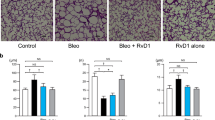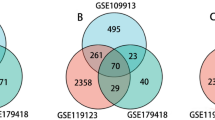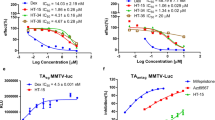Abstract
Background
Glucocorticoids (GCs) are highly effective yet problematic agents against bronchopulmonary dysplasia (BPD). The dimeric trans-activation of GCs induces unfavorable effects, while monomeric trans-repression suppresses inflammation-related genes. Recently, non-steroidal-selective glucocorticoid-receptor agonists and modulators (SEGRAMs) with only the trans-repressive action have been designed.
Methods
Using a bleomycin (Bleo)-induced alveolar simplification newborn rat model (recapitulating arrested alveolarization during BPD), we evaluated the therapeutic effects of compound-A (CpdA), a SEGRAM. Sprague-Dawley rats were administered Bleo from postnatal day (PD) 0 to 10 and treated with dexamethasone (Dex) or CpdA from PD 0 to 13. The morphological changes and mRNA expression of inflammatory mediators, including interleukin (IL)-1β, C–X–C motif chemokine ligand 1 (CXCL1), and C–C motif chemokine 2 (CCL2) were investigated.
Results
Similar to the effects of Dex, CpdA exerted protective effects on morphological derangements and inhibited macrophage infiltration and production of pro-inflammatory mediators in Bleo-treated animals. The effects of CpdA were probably mediated by GC receptor (GR)-dependent trans-repression, because unlike the Dex-treated group, anti-inflammatory genes specifically induced by GR-dependent trans-activation (such as “glucocorticoid-induced leucine zipper, GILZ”) were not upregulated.
Conclusions
CpdA improved lung inflammation, inhibited the arrest of alveolar maturation, and restored histological and biochemical changes in a Bleo-induced alveolar simplification model.
Impact
-
SEGRAMs have attracted widespread attention because they are expected to not exhibit unfavorable effects of GCs.
-
Compound A, one of the SEGRAMs, improved lung morphometric changes and decreased lung inflammation in a bleomycin-induced arrested alveolarization, a newborn rat model representing one of the main features of BPD pathology.
-
Compound A did not elicit bleomycin-induced poor weight gain, in contrast to dexamethasone treatment.
-
SEGRAMs, including compound A, may be promising candidates for the therapy of BPD with less adverse effects compared with GCs.
Similar content being viewed by others
Log in or create a free account to read this content
Gain free access to this article, as well as selected content from this journal and more on nature.com
or
Data availability
The datasets generated during and/or analyzed during the current study are available from the corresponding author on reasonable request.
References
Norman, M. et al. Association between year of birth and 1-year survival among extremely preterm infants in Sweden during 2004–2007 and 2014–2016. JAMA 321, 1188-1199 (2019).
Kusuda, S., Bennett, M. & Gould, J. Neonatal Research Network of Japan and the California Perinatal Quality Care Collaborative. Outcomes of Infants with Very Low Birth Weight Associated with Birthplace Difference: A Retrospective Cohort Study of Births in Japan and California. J. Pediatr. 229, 182–190 (2021).
Stoll, B. J. et al. Trends in care practices, morbidity, and mortality of extremely preterm neonates, 1993-2012. JAMA 314, 1039–1051 (2015).
Nakashima, T. et al. Neonatal Research Network of Japan. Trends in Bronchopulmonary Dysplasia Among Extremely Preterm Infants in Japan, 2003-2016. J. Pediatr. 230, 119–125 (2021).
Thébaud, B. et al. Bronchopulmonary dysplasia. Nat. Rev. Dis. Prim. 14, 78 (2019).
Álvarez-Fuente, M. et al. Preventing bronchopulmonary dysplasia: new tools for an old challenge. Pediatr. Res. 85, 432–441 (2019).
Papagianis, P. C., Pillow, J. J. & Moss, T. J. Bronchopulmonary dysplasia: Pathophysiology and potential anti-inflammatory therapies. Paediatr. Respir. Rev. 30, 34–41 (2019).
Filippone, M., Nardo, D., Bonadies, L., Salvadori, S. & Baraldi, E. Update on Postnatal corticosteroids to prevent or treat bronchopulmonary dysplasia. Am. J. Perinatol. 36, S58–S62 (2019).
Yeh, T. F. et al. Outcomes at school age after postnatal dexamethasone therapy for lung disease of prematurity. N. Engl. J. Med. 350, 1304–1313 (2004).
Doyle, L. W. Postnatal corticosteroids to prevent or treat bronchopulmonary dysplasia. Neonatology 118, 244–251 (2021).
Vettorazzi, S., Nalbantoglu, D., Gebhardt, J. C. M., & Tuckermann, J. A guide to changing paradigms of glucocorticoid receptor function—a model system for genome regulation and physiology. FEBS J. (2021) (epub ahead of print).
Vandevyver, S. et al. New insights into the anti-inflammatory mechanism of glucocorticoids: an emerging role for glucocorticoid-receptor-mediated trans-activation. Endocrinology 154, 993–1007 (2013).
Reichardt, S. D. et al. The role of glucocorticoids in inflammatory diseases. Cells 10, 2921 (2021).
Sundahl, N. et al. Selective glucocorticoid receptor modulation: new directions with non-steroidal scaffolds. Pharmacol. Ther. 152, 28–41 (2015).
Lesovaya, E. et al. Discovery of compound A—a selective activator of the glucocorticoid receptor with anti-inflammatory and anti-cancer activity. Oncotarget 6, 30730–30744 (2015).
Safy, M. et al. Efficacy and safety of selective glucocorticoid receptor modulators in comparison to glucocorticoids in arthritis, a systematic review. PLoS ONE 12, e0188810 (2017).
Louw, A. & Swart, P. Salsola tuberculatiformis Botschantzev and an aziridine precursor analog mediate the in vivo increase in free corticosterone and decrease in corticosteroid-binding globulin in female Wistar rats. Endocrinology 140, 2044–2053 (1999).
Bosscher, K. D. et al. A fully dissociated compound of plant origin for inflammatory gene repression. Proc. Natl Acad. Sci. USA 102, 15827–15832 (2005).
Alvira, C. M. & Morty, R. E. Can we understand the pathobiology of bronchopulmonary dysplasia? J. Pediatr. 190, 27–37 (2017).
Kolb, P. et al. The importance of interventional timing in the bleomycin model of pulmonary fibrosis. Eur. Respir. J. 55, 1901105 (2020).
Tourneux, P. et al. Inhaled nitric oxide improves lung structure and pulmonary hypertension in a model of bleomycin-induced bronchopulmonary dysplasia in neonatal rats. Am. J. Physiol. Lung Cell. Mol. Physiol. 297, L1103–L1111 (2009).
Sewing, A. C. et al. Therapeutic hypercapnia prevents bleomycin-induced pulmonary hypertension in neonatal rats by limiting macrophage-derived tumor necrosis factor-α. Am. J. Physiol. Lung Cell. Mol. Physiol. 303, L75–L87 (2012).
Cooney, T. P. & Thurlbeck, W. M. The radial alveolar count method of Emery and Mithal: a reappraisal 2—intrauterine and early postnatal lung growth. Thorax 37, 580–583 (1982).
Shivanna, B. et al. Omeprazole attenuates pulmonary aryl hydrocarbon receptor activation and potentiates hyperoxia-induced developmental lung injury in newborn mice. Toxicol. Sci. 148, 276–287 (2015).
Lee, A. H. et al. Pho-inase inhibitor prevents bleomycin-induced injury in neonatal rats independent of effects on lung inflamemation. Am. J. Respir. Cell. Mol. Biol. 50, 61–73 (2014).
Ee, M. T. et al. Leukotriene B4 mediates macrophage influx and pulmonary hypertension in bleomycin-induced chronic neonatal lung injury. Am. J. Physiol. Lung Cell. Mol. Physiol. 311, L292–L302 (2016).
Li, H. P., Li, X., He, G. J., Yi, X. H. & Kaplan, A. P. The influence of dexamethasone on the proliferation and apoptosis of pulmonary inflammatory cells in bleomycin-induced pulmonary fibrosis in rats. Respirology 9, 25–32 (2004).
Bai, L., Li, A., Gong, C., Ning, X. & Wang, Z. Protective effect of rutin against bleomycin induced lung fibrosis: Involvement of TGF-β1/α-SMA/Col I and III pathway. Biofactors 46, 637–644 (2020).
Ryan, R. M., Ahmed, Q. & Lakshminrusimha, S. Inflammatory mediators in the immunobiology of bronchopulmonary dysplasia. Clin. Rev. Allergy Immunol. 34, 174–190 (2008).
Groneck, P., Reuss, D., Gotze-Speer, B. & Speer, C. P. Effects of dexamethasone on chemotactic activity and inflammatory mediators in tracheobronchial aspirates of preterm infants at risk for chronic lung disease. J. Pediatr. 122, 938–944 (1993).
D’Angio, C. T. et al. Discordant pulmonary proinflammatory cytokine expression during acute hyperoxia in the newborn rabbit. Exp. Lung Res. 25, 443–456 (1999).
Londhe, V. A. et al. CXCR2/CXCR2 ligand biological axis impairs alveologenesis during ds RNA- induced lung inflammation in mice. Pediatr. Res. 58, 919–926 (2005).
Drebert, Z., Bracke, M. & Beck, I. M. Glucocorticoids and the non-steroidal selective glucocorticoid receptor modulator, compound A, differentially affect colon cancer-derived myofibroblasts. J. Steroid Biochem. Mol. Biol. 149, 92–105 (2015).
Malaise, O. et al. Glucocorticoid-induced leucine zipper (GILZ) is involved in glucocorticoid- induced and mineralocorticoid-induced leptin production by osteoarthritis synovial fibroblasts. Arthritis Res. Ther. 18, 219 (2016).
Desmet, S. J. et al. Compound A influences gene regulation of the Dexamethasone-activated glucocorticoid receptor by alternative cofactor recruitment. Sci. Rep. 7, 8063 (2017).
Bereshchenko, O., Migliorati, G., Bruscoli, S. & Riccardi, C. Glucocorticoid-induced leucine zipper: a novel anti-inflammatory molecule. Front. Pharmacol. 10, 308 (2019).
Dewint, P. et al. A plant-derived ligand favoring monomeric glucocorticoid receptor conformation with impaired trans-activation potential attenuates collagen-induced arthritis. J. Immunol. 180, 2608–2615 (2008).
Huynh, T. et al. Selective modulation through the glucocorticoid receptor ameliorates muscle pathology in mdx mice. J. Pathol. 231, 223–235 (2013).
Reber, L. L. et al. A dissociated glucocorticoid receptor modulator reduces airway hyperresponsiveness and inflammation in a mouse model of asthma. J. Immunol. 188, 3478–3487 (2012).
Brown, M. N. et al. Efficacy and safety of ADZ7594, an inhaled non-steroidal selective glucocorticoid receptor modulator, in patients with asthma: a phase 2a randomized, double blind, placebo-controlled crossover trial. Respir. Res. 20, 37 (2019).
Wigger-Alberti, W. et al. Comparison of occlusive and open application in a psoriasis plaque test design, exemplarily using investigations of mapracorat 0.1% ointment versus vehicle and reference drugs. Ski. Pharmacol. Physiol. 30, 102–114 (2017).
Owen, H. C., Miner, J. N., Ahmed, S. F. & Farquharson, C. The growth plate sparing effects of the selective glucocorticoid receptor modulator, AL-438. Mol. Cell. Endocrinol. 264, 164–170 (2007).
Baida, G. et al. REDD1 functions at the crossroads between the therapeutic and adverse effects of topical glucocorticoids. EMBO Mol. Med. 7, 42–58 (2015).
Britto, F. A. et al. REDD1 deletion prevents dexamethasone-induced skeletal muscle atrophy. Am. J. Physiol. Endocrinol. Metab. 307, E983–E993 (2014).
Rauner, M. et al. Dissociation of osteogenic and immunological effects by the selective glucocorticoid receptor agonist, compound A, in human bone marrow stromal cells. Endocrinology 152, 103–112 (2011).
Lesovaya, E. et al. Combination of a selective activator of the glucocorticoid receptor Compound A with a proteasome inhibitor as a novel strategy for chemotherapy of hematologic malignancies. Cell Cycle 12, 133–144 (2013).
Day, C. L. & Ryan, R. M. Bronchopulmonary dysplasia: new becomes old again! Pediatr. Res. 81, 210–213 (2017).
Wu, K. Y. et al. Characterization of disease phenotype in very preterm infants with severe bronchopulmonary dysplasia. Am. J. Respir. Crit. Care. Med. 201, 1398–1406 (2020).
Zhang, Z., Zhang, Z. Y. & Schluesener, H. J. Compound A, a plant origin ligand of glucocorticoid receptors, increases regulatory T cells and M2 macrophages to attenuate experimental autoimmune neuritis with reduced side effects. J. Immunol. 183, 3081–3091 (2009).
Acknowledgements
The authors would like to thank Kazumi Honda and Yumiko Yoshimura for assistance with the biochemical analysis, and Yusuke Onishi and Yasuhiro Ogino for assistance with the immunohistochemical analysis.
Funding
The authors have no financial relationships relevant to this article to disclose.
Author information
Authors and Affiliations
Contributions
S.I., T.O., and J.S. conceived and designed the research. S.I., J.S., and S.K. performed experiments and acquired data. S.I. prepared the manuscript. T.O. revised and edited the manuscript. D.N. helped in executing the statistical analysis. S.Y., Y.H., and A.A. critically reviewed the manuscript for important intellectual content. All authors have approved the final manuscript and agreed to be accountable for all aspects of the work.
Corresponding author
Ethics declarations
Competing interests
The authors declare no competing interests.
Additional information
Publisher’s note Springer Nature remains neutral with regard to jurisdictional claims in published maps and institutional affiliations.
Rights and permissions
Springer Nature or its licensor holds exclusive rights to this article under a publishing agreement with the author(s) or other rightsholder(s); author self-archiving of the accepted manuscript version of this article is solely governed by the terms of such publishing agreement and applicable law.
About this article
Cite this article
Ishikawa, S., Ogihara, T., Yamaoka, S. et al. A glucocorticoid-receptor agonist ameliorates bleomycin-induced alveolar simplification in newborn rats. Pediatr Res 93, 1551–1558 (2023). https://doi.org/10.1038/s41390-022-02257-8
Received:
Revised:
Accepted:
Published:
Issue date:
DOI: https://doi.org/10.1038/s41390-022-02257-8
This article is cited by
-
Resolvin D1 improves bleomycin-induced alveolar maturation arrest in newborn rats
Scientific Reports (2025)
-
Effects of postnatal corticosteroids on lung development in newborn animals. A systematic review
Pediatric Research (2024)



